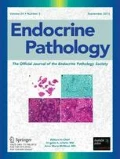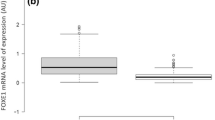Abstract
Insulin-like growth factor mRNA binding protein 3 (IMP3) is an mRNA-binding protein that regulates transcription of insulin-like growth factor II affecting cell proliferation during embryogenesis. It is highly expressed in carcinomas of the pancreas, stomach, colon, rectum, kidneys, uterine cervix, lung, and ovary. The purpose of our study was to evaluate IMP3 expression in thyroid follicular lesions, to determine whether it has a role in differentiating among these lesions, and to understand their biological relationships. We immunostained 219 thyroid lesions selected from our surgical pathology archives including 14 hyperplastic colloid nodules (CN), 19 Hashimoto's thyroiditis (HT), two Graves disease (GD), ten Hürthle cell adenoma (HCA), 20 follicular adenoma (FA), 37 conventional papillary thyroid carcinoma (PTC), 60 follicular variant of papillary carcinoma (FVPC), 19 Hürthle cell carcinoma (HCC), 32 follicular carcinoma (FC), and six poorly differentiated/anaplastic carcinoma. Immunohistochemistry was performed on formalin-fixed sections using monoclonal antibody to IMP3. Clinicopathological data were also reviewed. In all cases, residual thyroid tissue, CN, HT, GD, HCA, and FA were completely negative for IMP3 staining. Of the 60 FVPC, 23 tumors (38%) were positive for IMP3, with 13 of these (22%) showing very strong staining (3+). Of the 32 FC, 22 tumors (69%) were positive, with seven (22%) showing very strong staining (3+). Furthermore, 33 out of 37 cases (89%) of PTC were negative for IMP3. In all four PTC cases that did stain positive, staining was weak–moderate (1–2+). Similarly, 15 out of 19 cases (79%) of HCC were negative. No significant correlation was found between pathologic tumor characteristics and IMP3 expression in differentiated follicular pattern thyroid carcinoma. With 100% specificity and 69% sensitivity for FC as compared to FA and 100% specificity for FVPC, again compared to FA, IMP3 has the potential to be diagnostically useful in differentiating malignant and benign follicular pattern thyroid lesions. This study also points to a possible common biological relationship between FC and FVPC that requires further investigation.







Similar content being viewed by others
References
Baloch ZW, Livolsi VA. Follicular-patterned lesions of the thyroid: the bane of the pathologist. Am J Clin Pathol. 2002;17(1):143–150. doi:10.1309/8VL9-ECXY-NVMX-2RQF.
Khan AN, V. Pathology of Thyroid Gland. In: Lloyd RV, ed. Endocrine Pathology: Differential Diagnosis and Molecular Advances. Totowa, NJ: Humana Press Inc.; 2003:153-189.
Rezk S, Khan A. Role of immunohistochemistry in the diagnosis and progression of follicular epithelium-derived thyroid carcinoma. Appl Immunohistochem Mol Morphol 13(3):256-264, 2005. doi:10.1097/01.pai.0000142823.56602.fe.
Saggiorato E, De Pompa R, Volante M, et al. Characterization of thyroid ‘follicular neoplasms’ in fine-needle aspiration cytological specimens using a panel of immunohistochemical markers: a proposal for clinical application. Endocr-Relat Cancer 12(2):305-317, 2005. doi:10.1677/erc.1.00944.
Savin S, Cvejic D, Isic T, Paunovic I, Tatic S, Havelka M. The efficacy of the thyroid peroxidase marker for distinguishing follicular thyroid carcinoma from follicular adenoma. Experimental oncology 2006;28(1):70-4, 2006.
Wang S, Lloyd RV, Hutzler MJ, et al. Expression of eukaryotic translation initiation factors 4E and 2alpha correlates with the progression of thyroid carcinoma. Thyroid 11(12):1101-7, 2001. doi:10.1089/10507250152740939.
Wang S, Lloyd RV, Hutzler MJ, Safran MS, Patwardhan NA, Khan A. The role of cell cycle regulatory protein, cyclin D1, in the progression of thyroid cancer. Mod Pathol 13(8):882-7, 2000. doi:10.1038/modpathol.3880157.
Wang S, Wuu J, Savas L, Patwardhan N, Khan A. The role of cell cycle regulatory proteins, cyclin D1, cyclin E, and p27 in thyroid carcinogenesis. Human Pathol 29(11):1304-9, 1998. doi:10.1016/S0046-8177(98)90262-3.
Bartolazzi A, Gasbarri A, Papotti M, et al. Application of an immunodiagnostic method for improving preoperative diagnosis of nodular thyroid lesions. Lancet. 2001;357(9269):1644–1650. doi:10.1016/S0140-6736(00)04817-0.
Khan A, Baker SP, Patwardhan NA, Pullman JM. CD57 (Leu-7) expression is helpful in diagnosis of the follicular variant of papillary thyroid carcinoma. Virchows Arch. 1998;5:427–432. doi:10.1007/s004280050186.
Scognamiglio T, Hyjek E, Kao J, Chen YT. Diagnostic usefulness of HBME1, galectin-3, CK19, and CITED1 and evaluation of their expression in encapsulated lesions with questionable features of papillary thyroid carcinoma. Am J Clin Pathol 126(5):700-8, 2006. doi:10.1309/044V86JN2W3CN5YB.
Ito Y, Yoshida H, Tomoda C, et al. Galectin-3 expression in follicular tumours: an immunohistochemical study of its use as a marker of follicular carcinoma. Pathology 37(4):296-8, 2005. doi:10.1080/00313020500169545.
Mehrotra P, Okpokam A, Bouhaidar R, et al. Galectin-3 does not reliably distinguish benign from malignant thyroid neoplasms. Histopathology 45(5):493-500, 2004. doi:10.1111/j.1365-2559.2004.01978.x.
Mueller-Pillasch F, Lacher U, Wallrapp C, et al. Cloning of a gene highly overexpressed in cancer coding for a novel KH-domain containing protein. Oncogene 14(22):2729-2733, 1997. doi:10.1038/sj.onc.1201110.
Mueller-Pillasch F, Pohl B, Wilda M, et al. Expression of the highly conserved RNA binding protein KOC in embryogenesis. Mech Dev 88(1):95-9, 1999. doi:10.1016/S0925-4773(99)00160-4.
Yantiss RK, Woda BA, Fanger GR, et al. KOC (K homology domain containing protein overexpressed in cancer): a novel molecular marker that distinguishes between benign and malignant lesions of the pancreas. Am J Surg Pathol 29(2):188-195, 2005. doi:10.1097/01.pas.0000149688.98333.54.
Hanley KZ, Facik MS, Bourne PA, et al. Utility of anti-L523S antibody in the diagnosis of benign and malignant serous effusions. Cancer 114(1):49-56, 2008. doi:10.1002/cncr.23254.
Jiang Z, Chu PG, Woda BA, et al. Analysis of RNA-binding protein IMP3 to predict metastasis and prognosis of renal-cell carcinoma: a retrospective study. Lancet Oncol 7(7):556-564, 2006. doi:10.1016/S1470-2045(06)70732-X.
Jiang Z, Lohse CM, Chu PG, et al. Oncofetal protein IMP3: a novel molecular marker that predicts metastasis of papillary and chromophobe renal cell carcinomas. Cancer 112(12):2676-2682, 2008. doi:10.1002/cncr.23484.
Li C, Rock KL, Woda BA, Jiang Z, Fraire AE, Dresser K. IMP3 is a novel biomarker for adenocarcinoma in situ of the uterine cervix: an immunohistochemical study in comparison with p16(INK4a) expression. Mod Pathol 20(2):242-7, 2007. doi:10.1038/modpathol.3800735.
Simon R, Bourne PA, Yang Q, et al. Extrapulmonary small cell carcinomas express K homology domain containing protein overexpressed in cancer, but carcinoid tumors do not. Human Pathol 38(8):1178-1183, 2007. doi:10.1016/j.humpath.2007.02.001.
Wang T, Fan L, Watanabe Y, et al. L523S, an RNA-binding protein as a potential therapeutic target for lung cancer. Br J Cancer 88(6):887-894, 2003. doi:10.1038/sj.bjc.6600806.
Zhang JY, Chan EK, Peng XX, Tan EM. A novel cytoplasmic protein with RNA-binding motifs is an autoantigen in human hepatocellular carcinoma. J Exp Med 189(7):1101-10, 1999. doi:10.1084/jem.189.7.1101.
Zheng W, Yi X, Fadare O, et al. The oncofetal protein IMP3: a novel biomarker for endometrial serous carcinoma. Am J Surg Pathol 32(2):304-315, 2008. doi:10.1097/PAS.0b013e3181483ff8.
Mueller F, Bommer M, Lacher U, et al. KOC is a novel molecular indicator of malignancy. Br J Cancer 88(5):699-701, 2003. doi:10.1038/sj.bjc.6600790.
Asa SL. The role of immunohistochemical markers in the diagnosis of follicular-patterned lesions of the thyroid. Endocr Pathol 16(4):295-309, 2005. doi:10.1385/EP:16:4:295.
Fonseca E, Soares P, Cardoso-Oliveira M, Sobrinho-Simoes M. Diagnostic criteria in well-differentiated thyroid carcinomas. Endocr Pathol 17(2):109-117, 2006. doi:10.1385/EP:17:2:109.
Cheung CC, Ezzat S, Freeman JL, Rosen IB, Asa SL. Immunohistochemical diagnosis of papillary thyroid carcinoma. Mod Pathol 14(4):338-342, 2001. doi:10.1038/modpathol.3880312.
Mai KT, Ford JC, Yazdi HM, Perkins DG, Commons AS. Immunohistochemical study of papillary thyroid carcinoma and possible papillary thyroid carcinoma-related benign thyroid nodules. Pathol Res Pract 196(8):533-540, 2000.
Raphael SJ, Apel RL, Asa SL. Brief report: detection of high-molecular-weight cytokeratins in neoplastic and non-neoplastic thyroid tumors using microwave antigen retrieval. Mod Pathol 8(8):870-2, 1995.
Raphael SJ, McKeown-Eyssen G, Asa SL. High-molecular-weight cytokeratin and cytokeratin-19 in the diagnosis of thyroid tumors. Mod Pathol 7(3):295-300, 1994.
Sahoo S, Hoda SA, Rosai J, DeLellis RA. Cytokeratin 19 immunoreactivity in the diagnosis of papillary thyroid carcinoma: a note of caution. Am J Clin Pathol 116(5):696-702, 2001. doi:10.1309/6D9D-7JCM-X4T5-NNJY.
Goretzki PE, Simon D, Dotzenrath C, Schulte KM, Roher HD. Growth regulation of thyroid and thyroid tumors in humans. World J Surg 24(8):913-922, 2000. doi:10.1007/s002680010174.
Castro P, Eknaes M, Teixeira MR, et al. Adenomas and follicular carcinomas of the thyroid display two major patterns of chromosomal changes. J Pathol 206(3):305-311, 2005. doi:10.1002/path.1772.
Castro P, Rebocho AP, Soares RJ, et al. PAX8-PPARgamma rearrangement is frequently detected in the follicular variant of papillary thyroid carcinoma. J Clin Endocrinol Metab 91(1):213-220, 2006. doi:10.1210/jc.2005-1336.
Castro P, Roque L, Magalhaes J, Sobrinho-Simoes M. A subset of the follicular variant of papillary thyroid carcinoma harbors the PAX8-PPARgamma translocation. Int J Surg Pathol 13(3):235-8, 2005. doi:10.1177/106689690501300301.
Zhu Z, Gandhi M, Nikiforova MN, Fischer AH, Nikiforov YE. Molecular profile and clinical-pathologic features of the follicular variant of papillary thyroid carcinoma An unusually high prevalence of ras mutations. Am J Clin Pathol 120(1):71-7, 2003. doi:10.1309/ND8D9LAJTRCTG6QD.
Yantiss RK, Cosar E, Fischer AH. Use of IMP3 in identification of carcinoma in fine needle aspiration biopsies of pancreas. Acta cytologica 52(2):133-8, 2008.
Author information
Authors and Affiliations
Corresponding author
Rights and permissions
About this article
Cite this article
Slosar, M., Vohra, P., Prasad, M. et al. Insulin-Like Growth Factor mRNA Binding Protein 3 (IMP3) is Differentially Expressed in Benign and Malignant Follicular Patterned Thyroid Tumors. Endocr Pathol 20, 149–157 (2009). https://doi.org/10.1007/s12022-009-9079-x
Published:
Issue Date:
DOI: https://doi.org/10.1007/s12022-009-9079-x




